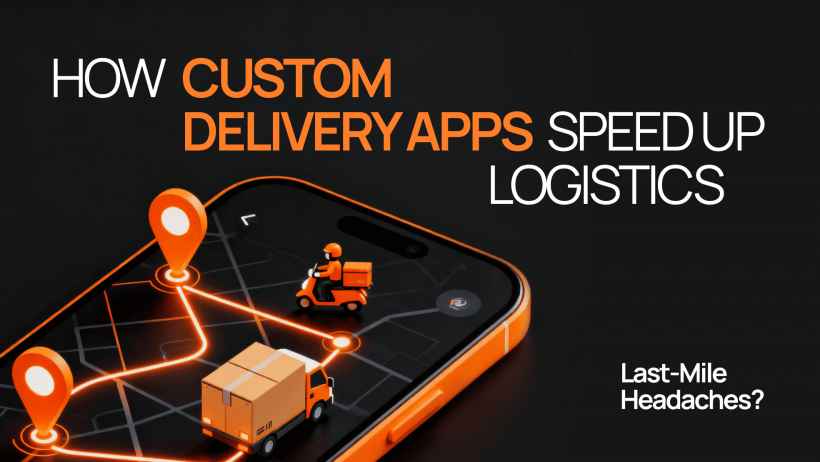Last-mile delivery is called "last mile" because it feels like the longest mile you'll ever drive.
Or the most expensive. Or the most frustrating.
This final stretch (warehouse to doorstep) somehow manages to cost more than everything that came before it. Traffic jams, wrong turns, customers who aren't home, routes planned by someone who's clearly never looked at a map. But here's the good news: we've figured out how to fix most of this.
The Growing Challenges of Last-Mile Logistics
Let's be honest. Last mile delivery is a nightmare dressed up as a business problem.
People want same-day delivery, real-time updates, precise time windows, and if you're five minutes late, they're already typing an angry review.
The numbers don't lie. According to our recent inner research, last-mile delivery accounts for 53% of total shipping costs, yet it's often the least optimized part of the entire supply chain.
Here's what's killing delivery operations right now:
- Traffic congestion that turns 20-minute routes into hour-long ones.
- Failed delivery attempts because nobody's home.
- Manual route planning that wastes fuel and time.
- Poor communication between drivers, dispatchers, and customers.
- Rising fuel costs that eat into already thin margins.
Why Businesses Need Last-Mile Delivery Software
Look, you can keep doing things the old way. Spreadsheets. Phone calls. Clipboards.
Or you can join 2025 and let last mile delivery software do the heavy lifting.
Modern last mile delivery optimization tools aren't just fancy GPS trackers. They're intelligent systems that think about your entire operation. Route optimization for last mile delivery handles stuff your brain simply can't process fast enough like recalculating 47 delivery routes in real-time when traffic suddenly backs up.
The best part? Automated delivery management means your team stops firefighting and starts actually managing. Dispatch becomes automatic. Route adjustments happen on the fly. Customers get updates without anyone needing to send them manually.
One logistics company cut their delivery times by 31% just by switching from manual planning to automated route optimization. They didn't hire more drivers. Didn't buy more vehicles. Just stopped wasting time on routes that made no sense.
Key Benefits of Custom Delivery Apps

Off-the-shelf solutions are fine if you run a generic business with generic problems.
But you don't.
Custom delivery apps built specifically for your operation understand your weird warehouse layout, your specific delivery zones, your unique customer requirements. They bend to fit your business instead of forcing you to adapt to someone else's idea of logistics.
Real-Time Tracking and Communication
Your customers don't want to wonder. They want to know.
Real-time delivery tracking isn't a luxury anymore, it's table stakes. But here's where custom solutions shine: they let you control exactly what information customers see and how they see it. Want to show a driver's photo? Done. Need automated text updates at specific checkpoints? Easy.
We're talking about customer-centric logistics apps that make people feel good about ordering from you instead of anxious.
Smart Route Optimization
Here's something that surprised me: the difference between "good" and "optimal" routing can be 20-30% of your delivery costs.
AI-powered algorithms for delivery route optimization software consider dozens of variables humans can't juggle: delivery time windows, vehicle capacity, driver schedules, traffic patterns, even weather conditions. The result? Routes that actually make sense instead of drivers zigzagging across town.
Last mile logistics suddenly becomes predictable. Imagine that.
Scalability Without the Headaches
Starting with 10 deliveries per day? Great. Growing to 1,000? Your scalable delivery solutions grow with you without requiring a complete system overhaul every six months.
That's the beauty of custom platforms, they're designed with your growth trajectory in mind.
Enhancing Customer Experience Through Personalization
Generic delivery apps treat everyone the same. Your business shouldn't.
Customer-centric logistics apps built specifically for your operation can remember that Mrs. Johnson prefers deliveries after 3 PM when she's home from work. That the apartment complex on Oak Street needs a gate code. That commercial customers want delivery confirmations sent to three different email addresses.
Off-the-shelf software makes you input this stuff manually every single time. Custom platforms? They learn and remember.
Comparing the Best Last-Mile Delivery Apps
So what makes a best last mile delivery app actually best?
| Feature | Why It Matters | What to Look For |
|---|---|---|
| Route Optimization | Reduces fuel costs and delivery times | Real-time adjustments, multi-stop optimization, traffic integration |
| Driver Mobile App | Keeps drivers efficient and informed | Offline capability, easy interface, proof of delivery features |
| Customer Notifications | Reduces "where's my order?" calls | Automated updates, multiple channels (SMS/email), ETA accuracy |
| Analytics Dashboard | Shows what's working (and what's not) | Real-time metrics, historical trends, cost breakdowns |
| Integration Capabilities | Connects with your existing tools | API access, eCommerce platforms, inventory systems |
Off-the-shelf on-demand delivery solutions work great if you're running a straightforward operation. You get started fast, costs are predictable.
But custom last mile delivery software wins when you've got complexity. Special handling requirements. Multiple delivery types. Integration with legacy systems that aren't going anywhere.
Some eCommerce companies save up to $200K annually by switching to a custom solution that integrates perfectly with their warehouse management system. It required manual data entry for every single order.
On-Demand Delivery Solutions for Modern Business
People got used to tapping a button and having food show up in 30 minutes. Now they expect the same speed for everything else. eCommerce delivery solutions that worked fine in 2019 feel ancient now.
I'm not saying every business needs to promise 30-minute delivery. But you do need flexibility. The ability to handle rush orders. To reroute drivers mid-shift. To accommodate last-minute changes without everything falling apart.
Custom last mile delivery solutions excel here because they're built around your specific on-demand requirements. Food delivery? Healthcare supplies? Retail same-day? Each industry has different needs, different compliance requirements, different customer expectations.
Consider healthcare. You can't just drop prescription medications on a doorstep and drive away. You need signature confirmation, age verification, temperature monitoring. A generic delivery app doesn't handle that complexity well. A healthcare last mile delivery solution does it automatically.
Route Optimization for Last-Mile Delivery
Traditional routing is basically the traveling salesman problem — figuring out the most efficient path through multiple stops. Sounds simple. But it's not. With just 10 stops, there are over 3 million possible route combinations.
But AI can. Modern route optimization for last mile delivery uses machine learning to continuously improve. It learns from past deliveries: which routes consistently run late, which neighborhoods have access issues, which customers are never home before 6 PM.

The environmental impact is different too. Eco-friendly delivery optimization isn't just good marketing, it's good business. Less time on the road means less fuel burned, lower carbon emissions. Some companies are seeing fuel consumption drop by 15-25% just from better routing.
One delivery company switched to AI-powered routing and discovered their drivers were collectively driving an extra 400 miles per day. They fixed it in three weeks.
Future Trends in Last-Mile Delivery Optimization
Drones and autonomous vehicles get all the hype, but honestly? They're still 5-10 years away from mainstream deployment. Current regulations and cost barriers make them impractical for most businesses.
What's happening now is more interesting anyway.
Predictive analytics are getting really good. Systems can now predict delivery volumes based on weather patterns, local events, social media trends. Imagine knowing three days in advance that you'll need 30% more delivery capacity because a heat wave is coming.
Data-driven logistics means every delivery teaches the system something new. Customer wasn't home at 2 PM on a Tuesday? The system remembers. Traffic on Main Street always backs up between 4-6 PM? Routes adjust automatically.
IoT sensors are making real-time delivery tracking software ridiculously precise. Not just "your package is out for delivery" but "your package is 4.2 miles away, current ETA 3:47 PM."
That level of transparency builds trust.
Sustainability is becoming non-negotiable too. Enterprise last mile logistics software now includes carbon footprint calculations, electric vehicle route planning, and consolidated delivery options.
According to a 2025 McKinsey report, 60% of consumers now consider delivery sustainability when choosing where to shop online, up from 43% in 2023.
And that's a fundamental shift.
Conclusion
Last mile delivery optimization is a really smart software solving really annoying problems.
Can you survive without it? Sure. Plenty of companies still operate on spreadsheets and prayer.
But you won't thrive. Not in 2025 when customers expect Amazon-level delivery experiences from everyone.
The good news? Custom delivery apps and modern last mile logistics platforms have become incredibly accessible. You don't need a seven-figure budget anymore. You need clarity on your requirements and partners who understand delivery operations.
So, ready to stop treating last-mile delivery like an unavoidable headache and start treating it like the competitive advantage it can be?

Your customers (and your drivers) will thank you.
FAQ
What is the difference between last-mile delivery software and route optimization tools?
Route optimization is one feature within last mile delivery software. Route optimization figures out the best path, while complete delivery software handles routing plus dispatching, tracking, customer communication, proof of delivery, and analytics.
How can small businesses benefit from custom delivery apps?
Small businesses often have unique constraints that off-the-shelf solutions don't address. Cost-effective delivery software customized for your specific area and delivery types can actually be cheaper long-term than paying for features you'll never use.
What makes an on-demand delivery solution successful?
Speed, transparency, and reliability. Your customers need to know exactly when their delivery will arrive. On-demand delivery solutions that provide real-time updates and consistently hit delivery windows win customer loyalty.
Are custom last-mile delivery apps more cost-effective long term?
Usually, yes, if you have sufficient delivery volume. The breakeven point is typically around 500-1000 deliveries per month. Below that, off-the-shelf might make more sense. Above that, custom solutions typically pay for themselves within 12-18 months.
How does last-mile optimization impact customer satisfaction?
Directly and significantly. Delivery experience affects repeat purchase rates more than product quality in many categories. Last mile delivery efficiency translates to faster deliveries, accurate ETAs, and fewer failed attempts, all of which make customers happy.
Which industries gain the most from best last-mile delivery apps?
Food and grocery, healthcare and pharmaceuticals, eCommerce retail, and home services see the biggest impact. Any industry where delivery speed and reliability directly influence customer decisions benefits enormously from scalable last mile delivery platforms.
What challenges do companies face when implementing last-mile delivery software?
Driver adoption is challenge number one. Integration with existing systems is a close second. Then comes data migration and process changes. Expect 2-3 months of adjustment period before you see full benefits.

